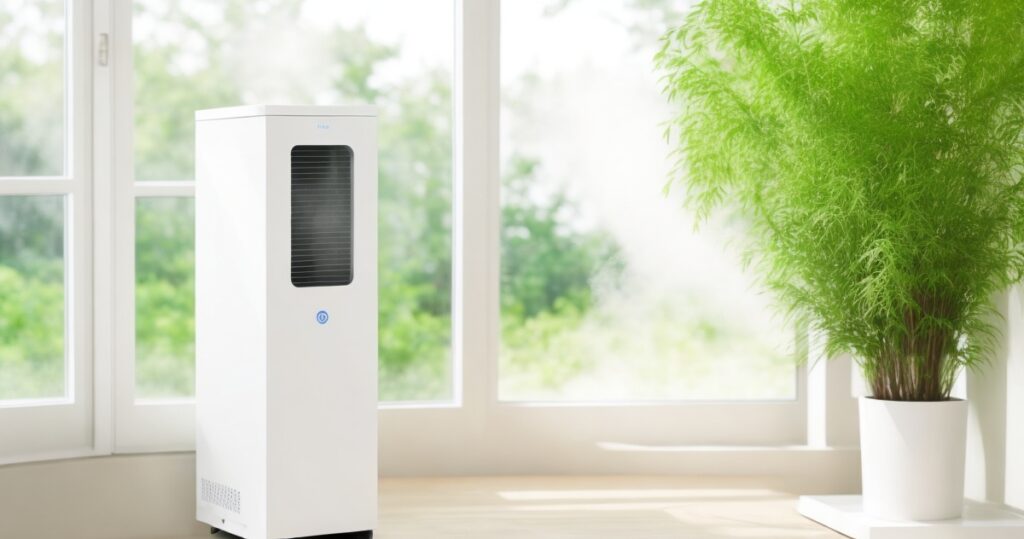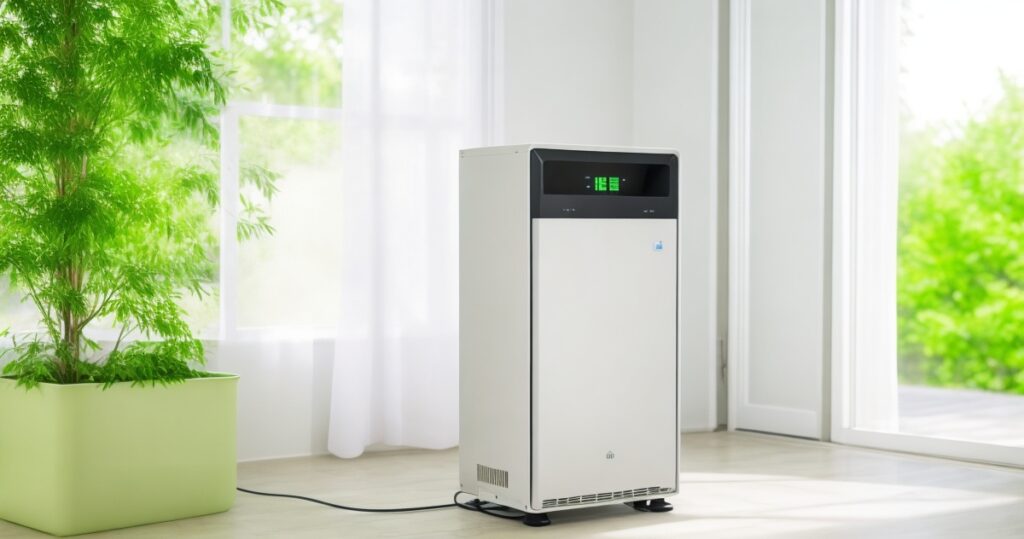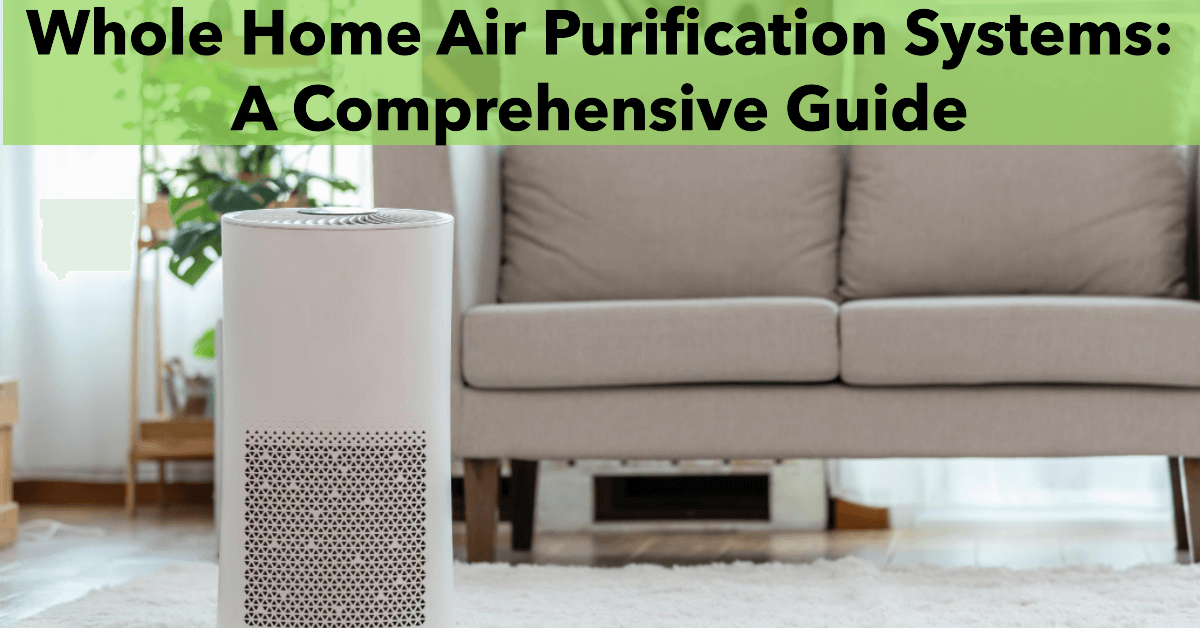Whole Home Air Purification Systems are integrated systems designed to improve the air quality throughout an entire house. Unlike the portable air purifiers, which clean the air in a single room or a specific area, whole home air purification system are connected to a home’s HVAC (Heating, Ventilation, and Air Conditioning) system, allowing them to purify the air across all rooms.
In this comprehensive guide, we’ll explore how these systems work, their benefits, and why you might consider installing one in your home. You’ll discover their types, benefits, installation, and much more, to help you make informed decisions for your family’s well-being.
How Whole Home Air Purification Systems Work
Whole home air purification systems are integrated into your home’s HVAC (Heating, Ventilation, and Air Conditioning) system. They purify the air as it circulates around your home.
There are four steps in which we can define how they work:
1. Air Intake
Firse HVAC system draws in air from your home. This air often contains dust, pollen, pet dander, smoke, and other pollutants.
2. Filtration
As the air is drawn in, it passes through a series of filters. These filters are the core of the purification system. There are several types of filters used in whole home air purification systems:
- Pre-filters: These capture large particles like dust and hair.
- HEPA (High-Efficiency Particulate Air) Filters: These filters are renowned for their ability to trap tiny particles, including dust, pollen, pet dander, and even some microorganisms.
- UV-C (Ultraviolet-C) Light Sterilization: UV-C light is used to disinfect the air by neutralizing bacteria, viruses, and mold spores.
- Activated Carbon Filters: These filters excel at capturing odors, volatile organic compounds (VOCs), and chemicals, leaving your home smelling fresh.
3. Air Treatment
After filtration, the air may go through additional treatments. Some systems use ionizers to charge particles, making them easier to capture. Others use photocatalytic oxidation to break down pollutants at a molecular level.
4. Air Distribution
Finally, the purified air is circulated back into your home through the HVAC system. This ensures that every room in your house benefits from clean air

.
Types of Whole Home Air Purification Systems
We can see different types of whole home air purification systems, each with its own set of features and benefits. The most common types:
1. HEPA Filtration Systems
HEPA filtration systems are very effective at removing particles from the air. They can capture particles as small as 0.3 microns which makes them ideal for homes with allergies or asthma sufferers.
2. UV Air Purifiers
UV air purifiers use ultraviolet light to kill bacteria, viruses, and mold spores. They are excellent for improving indoor air quality and reducing the spread of illnesses.
3. Electrostatic Air Purifiers
These systems use electrostatic precipitators to charge particles in the air. The charged particles are then attracted to oppositely charged plates, where they are captured. These systems are effective at removing dust, smoke, and other fine particles.
4. Activated Carbon Filters
Activated carbon filters are known for their ability to remove odors and chemical pollutants. They are often used in combination with other filtration methods for comprehensive air purification.
5. Hybrid Systems
Hybrid systems combine multiple filtration methods to provide the best air purification. For example, a system may use HEPA filtration, activated carbon filters, and UV light for a multi-layered approach to air cleaning.

Installation and Maintenance
Installing a whole home air purification system requires professional expertise and help. Things to expect during the installation process are:
Installation Process
- Assessment: A professional will assess your home’s HVAC system and determine the best type of air purifier for your needs.
- System Placement: The air purifier is installed within the ductwork, either in the return air duct or the main supply duct, depending on the system’s design and specifications.
- Integration: The air purifier is integrated into your existing HVAC system. This may involve installing filters, UV lights, or other components.
- Sealing and Testing: The installation is sealed and tested to ensure that it functions correctly, with no air leakage or performance issues.
Maintenance Tips
To keep your system running efficiently, regular maintenance is essential. Here are some tips:
- Change Filters: Replace filters according to the manufacturer’s recommendations. This is typically every 3-6 months.
- Clean Components: Clean any reusable filters and components regularly to prevent buildup.
- Check UV Lights: If your system uses UV lights, check them periodically to ensure they are still functioning. UV bulbs may need to be replaced annually.
- Professional Inspections: Have your system inspected by a professional annually to ensure it is operating at peak efficiency.
Health and Allergy Benefits
These systems can alleviate allergies, improve overall health, and the research that supports their impact on well-being.
Alleviating Allergies and Respiratory Issues
Whole Home Air Purification Systems are engineered to address these concerns by removing allergens from the air. The combination of HEPA filters, UV-C sterilization, and activated carbon filters ensures that these systems capture and neutralize a wide range of allergens.
Improving Overall Health and Well-being
Good health isn’t just about the absence of illness; it’s also about well-being and vitality. Breathing clean, fresh air is a fundamental element of well-being, and Whole Home Air Purification Systems play a vital role in ensuring that your home promotes good health.
Studies and Research on Air Quality and Health
While the health benefits of clean air might seem like common sense, they are also backed by scientific research. Numerous studies have explored the relationship between indoor air quality and health, consistently finding that cleaner air leads to better health outcomes.
These studies have shown that improved indoor air quality can lead to:
- Reduced Allergy Symptoms: Clean air is associated with a decrease in allergy symptoms, offering relief to allergy sufferers.
- Lower Risk of Respiratory Illness: Individuals exposed to cleaner air are less likely to develop respiratory conditions like asthma and bronchitis.
- Enhanced Overall Well-being: Breathing clean air leads to a higher quality of life, with individuals reporting increased energy and vitality.
Conclusion
Whole home air purification systems can be your excellent investment for maintaining clean, healthy air in your home. They offer you superior air quality, health benefits, convenience, and improved HVAC efficiency. With various types available, you can choose a system that best suits your needs. Proper installation and maintenance are key to ensuring your system operates effectively.
FAQ
How much does a whole home air purifier cost?
Whole home air purifier costs can range from $1,000 to $5,000 or more, depending on the brand, features, and size of your home.
How does a Whole Home Air Purification Systems work?
These systems use various technologies like HEPA filters, UV-C lights, and activated carbon to capture and eliminate airborne pollutants, allergens, and contaminants. They are installed within your HVAC system to treat the air as it passes through.
DheerajSonwane is a dedicated writer with expertise in air purification technologies. He focuses on providing well-researched content to help readers improve indoor air quality in homes and businesses. As the lead writer at AirPurifierMaster.com, Dheeraj offers practical advice his insightful reviews guide individuals in choosing the best air purifiers for their needs.

